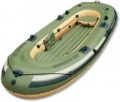Load capacity
The maximum weight of cargo that the boat is normally designed to carry. The cargo in this case includes both passengers and their luggage, as well as the engine and various additional equipment.
The carrying capacity stated in the characteristics clearly cannot be exceeded: although most inflatable boats are able to stay afloat even with severe overload, in such conditions controllability and stability noticeably deteriorate, wear increases and the likelihood of damage to the bottom or cylinder increases. We also note that there is no strict connection between the carrying capacity and the number of seats (see above): models with the same number of seats can differ significantly in permissible load. And it is important to take
boats with a large carrying capacity if necessary, because this affects the density of materials, overall weight and price.
Seats
—
Rigid. Seats in the form of planks, usually attached to both sides across the boat. Considered more reliable than inflatables, they have a traditional flat surface and are cheaper due to their simple design. On the other hand, when folded, the hard seats take up more space, and the convenience for passengers is purely symbolic.
—
Rigid sliding. The rigid bars described above with the ability to adjust the location along the boat. They allow you to change the distance between the seats, or even combine two into one.
—
Inflatable. Inflatable seats are easy to use and quite comfortable. They usually do not require special fasteners, and by changing the degree of pumping, you can change the hardness, adjusting the properties of the surface to the preferences of a particular person. In addition, such seats, when deflated, take up a minimum of space. Their main disadvantage is their relatively high cost.
—
Soft. A type of seat used primarily in kayaks (see "Type"). They have a rigid base covered with foam rubber or other similar material, often equipped with backs. This design provides comfort on long trips and at the same time allows you to maintain maximum control over the boat.
— None. Some boats may not come with seats at all. One of the varieties of such models is miniature rowing boats (see "T
...ype"), designed for one or two people and equipped with an inflatable flat bottom (see "Bottom type"), which plays the role of a seat. The second option is multi-seat boats, for which "seats" must be purchased separately, depending on the features of the planned application.Balloon diameter
The diameter of the boat's balloon — the inflatable shell that forms the sides — in a fully inflated state. This parameter primarily affects the dimensions of the cockpit (see below): with the same dimensions of the boat, a thicker cylinder leaves less space in the cockpit. Also, the carrying capacity is somewhat related to the diameter —
a large cylinder usually holds more air and gives more buoyancy; however, in fact, the possibilities for transporting goods are also highly dependent on the characteristics of the bottom and the overall strength of the structure.
Dimensions (LxW)
The dimensions of the inflated boat in length and width, along the outer edges (excluding oars, motor, etc.). This parameter allows you to estimate how much space the vessel will occupy in the working position. In addition, the first size value — length — indicates other parameters: the larger it is, the better the boat is suitable for gliding and, usually, its capacity is greater (see "Number of seats").
Weight
The total weight of the boat with oars and decking (if any), but excluding the motor and additional attachments. The lighter the boat, the more convenient it is to carry, however, a small weight can affect either the price or the quality (compared to analogues). Weight also affects speed characteristics — a
lighter boat is easier to accelerate to high speed with the same motor power; however, do not forget that these characteristics also depend on the material, the shape of the bottom and many other parameters.
Paddles
Oars can be equipped with all types of boats - even motor ones. The convenience of such a configuration (in relation to
boats without oars) lies primarily in the fact that the “native” oars are optimally suited to the boat in terms of size and design features.
Repair kit
Boat inflatable shell repair kit. The minimum composition of the
repair kit is patches and a composition for fixing them (another option is self-adhesive or even “liquid” patches). In addition, the kit may include sealant, gasoline for degreasing repaired surfaces and other items. Of course, serious damage with the help of a repair kit is unlikely to be patched, however, with small holes, cuts, etc. it might come in handy.
Boat bag
A special bag for storing and carrying a folded boat and additional equipment for it (oars, a pump, etc.).
A bag for a boat is most often much more convenient than impromptu packaging, since it is optimally suited for a boat in terms of size and design features.

